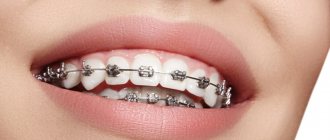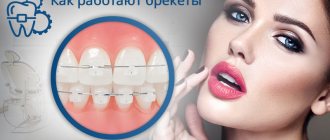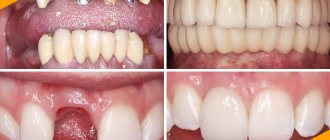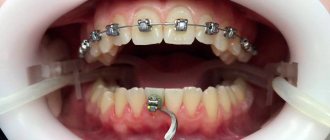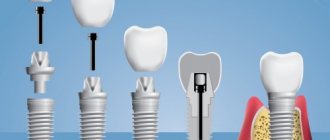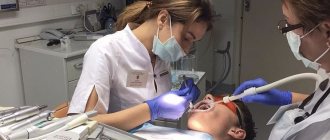Everything you would like to know about correcting your bite and straightening your teeth with braces.
Let's be honest: in modern realities, a beautiful smile is the norm, and it is necessary to get rid of dental imperfections. But, having set such a goal, it is desirable to have reliable information about existing methods and upcoming tests. We tried to collect in one article all the most important things about braces in order to save you from having to look for answers on your own on the Internet, where the truth is mixed with myths and advertising fluff.
Important! In the article, prices are indicated for St. Petersburg and the Leningrad region.
How are braces different from aligners?
This question worries many: is it possible to pay more, but get by wearing transparent removable aligners? The truth is that nice aligners can only cope with minor problems (for example, with one tooth that has grown incorrectly), but only fixed structures - those same “ugly braces” - can create an orthodontic load to shift the dentition.
As for cap-aligners, to achieve the effect, it is recommended to wear them at least 22 hours a day, removing them only during meals. As practice shows, a person often violates such rules by being distracted, forgetting, or simply allowing himself some indulgence. Strictly speaking, aligners are not intended to correct bites, and if they are positioned as such on the clinic’s website, it is better to turn to other specialists.
And the financial point: you will have to pay not more for the aligners, but much more, because during the treatment period they need to be changed at least 15 times (and sometimes much more), so the average minimum cost of correction with the help of aligners should be considered an amount of about 250- 300 thousand rubles.
What will help you cope with pain?
If you follow all the doctor's recommendations and properly care for your teeth and braces, pain may not occur at all, only some discomfort.
If the pain does not go away, then it is worth checking how the braces are installed; perhaps some mistakes were made that only a doctor will correct.
What other recommendations might there be for patients experiencing pain in braces?
- Dietary restrictions - switching to liquid and pureed foods. - How do you like this option?
- Treatment of braces with dental wax.
- Take painkillers only as prescribed by a doctor!
Diet restrictions
If you have braces, be prepared to change your diet and avoid foods that are hard, fibrous, or too hot or cold. Because this can break your braces, damage your teeth, or increase pain.
After installing the system, you should wait at least one hour before you can eat liquid or soft food. Soups, pureed porridge and even baby food are the basis of your diet during bite correction. And, by the way, you will have to brush your teeth very, very carefully, since food will constantly get stuck there, forming plaque:
Special wax
In pharmacies you can buy orthodontic wax, which is applied to braces and helps reduce pain from friction and pressure of the device on the mucous membranes and teeth.
Taking painkillers
Any medications, even the seemingly safest ones, should be used only after consultation with a specialist and after carefully reading the instructions, contraindications and side effects of these medications. By mindlessly taking any medications, you can only seriously harm yourself, always remember this!
For irritation of the mucous membrane, rinsing with chamomile decoction helps a lot. Of course, with one “but” - if you are not allergic to it.
CONCLUSION
: In case of any incomprehensible sensations, we recommend that you contact your doctor so as not to miss serious points during treatment.
We still have one important question, which we promised to answer at the very beginning of the article, here it is:
Installing and wearing braces: does it hurt?
When installing braces, the vast majority of patients do not experience any noticeable pain, but discomfort certainly appears, and you will have to get used to the braces - for some faster, for others longer, on average - 1-2 days. The exception is, perhaps, people with a very low pain threshold or with increased impressionability - it is from them that the myths about the pain of installing and wearing braces come.
In fact, sometimes there is irritation of the mucous membranes of the lips and cheeks. To solve this problem, a special wax is used, which the doctor will definitely suggest after installation.
Adaptation.
The length of the adaptation period takes 3-14 days - it all depends on the chosen design, following the dentist’s advice and the individual characteristics of the child. This time is the most difficult, as the teeth get used to the load, acquire some mobility and begin to change their position, trying to take the correct place in the bite. The patient feels severe discomfort and pain. You can reduce discomfort by adjusting the menu towards soft foods and taking prescribed sedatives.
I’ll take off my braces, a couple of years will pass, and my teeth will return to their place... is this true?
But this is true - but from the practice of past years! Now, after removing braces, the dentition is secured using a special non-removable retainer apparatus; previously this was not always done - hence the accumulated complaints. Today, orthodontists are required to install such a device.
A retainer is a thin wire that is installed on the inside of the front teeth and prevents them from moving apart. And this is for the rest of your life, but you shouldn’t worry: the delay is imperceptible, those around you don’t see it, and if it breaks, it’s easy to fix—just don’t delay your visit to the doctor.
Another problem is more pressing: sometimes, after straightening the dentition, previously hidden aesthetic defects (for example, different lengths of teeth) become noticeable. In this case, you will really have to resort to restoration or buy expensive veneers.
Important! The orthodontist must notice such defects and warn the patient before starting treatment.
History of the creation of braces
Doctors of the ancient world of the 9th - 6th centuries BC straightened teeth using improvised devices. In 1728, surgeon Pierre Fauchard published a study, one chapter of which was devoted to orthodontics. In the 9th century, the American Edward Engle created the first prototype of the braces system. The scientist invented four devices:
- E-arc gold alloy;
- modification of the E-arch with pins and tubes;
- ribbon arc;
- edgewise braces.
The operating principle of the structures underlies the operation of 21st century braces.
The E-arch, which expands the dentition, was made of a gold alloy and fixed into rings installed on the molars. Each tooth was tied to an arch with wire. Subsequently, Engle refined the design: adjustable tubes appeared on each tooth and pins on the arch. The pins fixed the arch into the slots, the doctor adjusted the pins, and the teeth moved. The system was not actively used in clinical practice, and the E-arm remained an intermediate option.
Later, an American scientist created a ribbon arch. Engle replaced the tube design on each tooth with a vertical rectangular groove. The crowns of the teeth tilted under the influence of the arc, but the roots remained in place. The limitation in the width of the groove and the low elasticity of the arc did not allow the torque to be controlled.
In 1928, Edward Engle designed the edgewise braces system. The scientist compared the geometry of the groove and the arc and replaced the ribbon arc with a rectangular wire. Engle established the slot size of 0.022 x 0.028 inches, which is what 21st century orthodontists use.
Edgewise braces were not wide enough to rotate the tooth under the force of the archwire. To achieve the result, orthodontists installed two braces on the tooth at once. The design formed the basis of ligature systems. With the development of orthodontics at the beginning of the 20th century, the gold alloy from which the arch was made was replaced by stainless steel. The increased rigidity of the steel compensated for the reduced arc thickness. A groove size of 0.018 x 0.025 inches has appeared, which, along with 0.022 x 0.28, is used in practice by orthodontists.
Damon Clear with arc
Do braces damage enamel and lead to caries?
No, the tight fit of the braces completely eliminates the penetration of food debris and microbes into the tooth; Dental enamel glue used in practice is harmless, moreover, it contains the useful element fluorine. The brace-lock even protects the tooth in a certain way.
But improper care of braces is really fraught with trouble: oral hygiene after installation of an orthopedic structure requires more attention and responsibility due to the increased accumulation of plaque. And where there is plaque, there is caries!
Why is pain in braces normal?
The reason that braces are painful to wear is due to the mechanical impact of external factors on the teeth. The spring causes the bones to shift, causing the gums and alveolar openings of the jaw to become involved.
Metal products oxidize under the action of amylase and rub the mucous membranes. The oral cavity is characterized by an aggressive environment where bacteria and leukocytes constantly reside. If pathogenic microorganisms enter the wound caused by the friction of braces, an ulcer occurs. It begins to irritate, the mucous membrane becomes irritated, and there is a burning sensation and pain. Thanks to the leukocytes contained in saliva and intensive blood supply, the infection quickly passes. After a week, the wound heals on its own.
Such ulcers form in the first months of wearing braces. After the oral cavity adapts to the changes that have arisen, the mucous membrane thickens, so the wounds stop bothering the person.
Is it necessary to use additional products to clean braces?
On forums (and sometimes in the recommendations of “experts”!) there are numerous additional products that supposedly make oral hygiene easier in the presence of braces (rinses, ultrasonic brushes, etc.)
In fact, with a responsible approach, it is quite possible to get by with three basic tools (toothbrush, dental floss, brush). In this case, you should not rely on someone else’s opinion. The quality of care will be assessed by a doctor who conducts regular examinations, and he will also recommend additional remedies, if necessary.
Can adults get braces to correct their bite?
Anyone can correct a malocclusion, regardless of age. But in an adult, this process takes longer than in children, because skeletal growth has already stopped and hard bones are more difficult to form.
In addition, some oral health conditions may delay the installation of braces. For example, caries, periodontal disease, endocrine diseases.
Sometimes the effect of treatment is influenced by the presence of crowns and bridges. The treatment period starts from 1.5 years.
Is there a need to give up your usual food?
As a rule, when installing a brace system, the doctor will actually announce “forbidden” foods, and this list looks quite depressing (cookies, chips, seeds/nuts, crackers, chewing gum, pizza, chocolate bars, etc. - everything that can stick to the structure , creating conditions for the proliferation of microbes, or damaging it). But in this case, the doctor’s recommendations should be approached in a differentiated manner: there is a clear reinsurance here, the only thing that is actually required from the patient is caution.
Contraindications
There is a fairly large list of contraindications for installing the design for children.
They are not installed in the following conditions:
- age under eleven years;
- inability to ensure sufficient oral hygiene;
- oncological diseases;
- mental illness (oligophrenia, schizophrenia);
- blood pathology;
- tuberculosis;
- diseases of the heart and blood vessels;
- endocrine pathologies;
- extensive caries;
- gingivitis;
- osteoporosis
- HIV.
Most of these contraindications are absolute; under no circumstances should structures be installed. Others are considered relative; when inflammatory processes are cured, corrective systems can be installed.
Is it true that sapphire braces are the best?
Sapphire braces are much more expensive than iron braces, but their advantages do not lie in the effectiveness of treatment. Moreover, in reliability they are inferior to metal ones. But on the teeth, such brace systems look much more aesthetically pleasing, since transparent brace locks are almost invisible.
Let us clarify: the precious natural stone sapphire has nothing to do with the production of such briquettes; we are talking about artificially grown crystals.
By the way, there are also cheaper transparent braces - ceramic (much more expensive than metal ones, but not as expensive as sapphires) and plastic designs. Only the former are too fragile and unstable in relation to food dyes (can lead to yellowing of teeth), and the latter are intended only for short-term use.
How to choose a brace system
The primary task for the patient is to find a doctor with whom a trusting relationship will be established. The orthodontist will conduct a diagnosis, discuss a treatment plan and offer several braces to choose from. The doctor recommends braces based on the patient’s financial capabilities, the complexity of the clinical case and the anatomical features of the dentition. The decision-making is influenced by the doctor’s personal preferences - some specialists work only on self-ligating braces using the straight arch technique, others prefer a multi-loop arch and ligature structures.
young man with Ormco translucent self-ligating braces
Ceramic and sapphire systems are chosen to partially camouflage orthodontic treatment. Bite correction with clear braces takes longer than with metal Damon Q braces due to the higher friction of the archwire and ceramic groove bottom.
treatment with Inspire Ice
How much do simple metal braces cost?
The remarkable cheapness of hardware is just a myth supported by some clinics. Indeed, by indicating the cost of one element of the braces system, they create the illusion of affordable treatment, but the patient should understand that the treatment process involves paying for braces, dental materials, multiple visits to the doctor and various procedures, including removal of the system at the end of treatment - and all this will cost at a very decent amount.
On average, the price of a course of treatment in an ordinary case (healthy teeth, simple defect) is 150-170 thousand rubles. (and this does not take into account preliminary professional teeth cleaning and diagnostics). If you have tooth decay and/or gum problems, you should add the cost of treatment or surgery to this amount. After removing the braces, you will have to pay for the installation of retainers, and, if necessary, restoration or installation of veneers.
Important! There is no point in finding out the cost of braces over the phone, since each case is individual; choose the clinic where they will tell you the amount of all necessary procedures and operations - so to speak, the amount of “turnkey” treatment.
Duration of treatment
How long do you wear braces? Treatment with ligature structures averages 2.5 – 3 years. Self-ligating devices are usually worn for 1 – 2.5 years. The duration of treatment depends on the model of braces, the experience of the doctor, the complexity of the clinical case and cooperation with the patient. If you do not wear elastics and do not follow the orthodontist's recommendations, treatment will slow down.
girl with Mini Diamond metal braces
The patient comes to the appointment with the regularity specified by the doctor. At the initial stage of treatment with a self-ligating brace system, the intervals between visits are 8 – 10 weeks. During the basic mechanics phase, the patient visits the orthodontist every month. When installing ligature structures, he comes for activation at least once a month at each stage of treatment.
teenagers with Ormco braces
What are the advantages of ligature-free braces? And do they exist?
Ligatures are wires or elastic rings with the help of which bracket locks are attached to the arch. In ligature-free bracket systems, the arch is inserted into a special clip, and ligatures are not needed.
Self-ligating braces (also known as self-ligating braces) have been aggressively promoted for some time, causing their prices to rise. However, time and practice have shown that the advantages attributed to such systems are absent (including the myth about the special strength achieved due to minimal friction of the archwire with the bracket locks).
How to get a tax deduction for treatment with braces
For three years, Russian tax residents can claim a tax deduction for treatment with braces. Taxpayers receive a refund from the state in the amount of 13% of the amount spent on their own treatment, treatment of minor children, parents or spouses. Only the personal income tax that the taxpayer paid to the state for the last year is returned.
Package of documents for the tax office:
- declaration 3-NDFL;
- certificate from place of work 2-NDFL;
- documents from the clinic - a copy of the treatment agreement, a copy of the clinic’s license, a certificate of payment for treatment, cash receipts.
A person who has undergone orthodontic treatment and is claiming a refund must file a tax return by the end of April.
The state returns 13% of the maximum 120,000 - 15,600 rubles. The material is for informational purposes only and is presented for informational purposes. It does not replace consultation with an orthodontist and is not a guide to correcting dental anomalies.
Are lingual braces worth their high cost?
The most expensive lingual brace systems today are much more expensive than expensive sapphire braces; correction costs the patient up to 500 thousand rubles. But progressive doctors have already abandoned this solution, the only advantage of which is invisibility to others due to installation on the inside of the teeth.
This only advantage is greatly diluted by numerous disadvantages: adaptation to such systems is more difficult and longer (up to several months), the likelihood of injury to the tongue is high, the effect on diction is more pronounced, the requirements for caring for them are stricter, and recovery in case of peeling is more difficult.
#3 Can take a long time
This is true. Depending on the defects, you will have to wear braces from six months to three years. But even after the specified period, everything does not end. After removing the braces, you will need to install retainers, which will have to be worn for the same amount of time. Retainers are installed to prevent teeth from returning to their previous position.
If you decide to install braces, you will have to come to terms with the idea that it will last a long time. Think positively and be patient, because the result will be worth it.
Is it possible to put braces on only one jaw?
Many patients are perplexed: why, if, for example, 1-2 upper teeth are displaced, why install a system on the entire jaw. The desire to minimize inconvenience and costs is quite understandable, but the realities are different: teeth are straightened not by braces, but by the device that is attached to them, and the force of its influence must be uniform, which requires fixation on the entire dentition. Otherwise, the “crooked” tooth will fall into place, but will inevitably push others out of the row.
The concept of a “partial bracket system,” however, exists - such systems are installed on one jaw and cost half as much. However, such a correction is possible only in the absence of bite pathologies and strict symmetry of the teeth of the upper and lower jaws, when there is only a slight curvature of 1-2 teeth (according to statistics, in orthopedic practice there are no more than 5% of such cases).
Can you continue to live with crooked teeth?
Crooked teeth are more vulnerable to tooth decay and periodontal disease. If teeth grow incorrectly, their surfaces become excessively worn down when eating, which worsens the malocclusion. Therefore, sometimes it leads to serious diseases of the temporomandibular joints.
In addition, if you suffer from frequent headaches, chondrosis, or have tinnitus, it is better to check your bite.
Is it possible to install and wear braces during pregnancy?
Pregnancy is a period of serious changes in a woman’s body, including, among other things, bone tissue, tooth roots and bone plates. This is definitely a stressful condition, which should not be aggravated.
Thus, it is strictly forbidden to begin correcting the bite if there are plans to expand the family or in the process of bearing a child, and if an unplanned pregnancy occurs during the current course of correction, the brace system must be removed as quickly as possible.
#4 Braces are expensive
Let's not deny this fact. Especially if you plan to install expensive options, such as self-regulating sapphire systems. If beauty does not play a big role, then you can opt for metal braces. They perform the same function and are no different in efficiency.
The period of wearing braces is quite long and you can pay in installments. Monthly payments will be small and will not affect the family budget.
At what age is it better to start correcting a child’s bite?
The optimal age to begin orthodontic treatment is after the formation of the bite is completed (usually at 11-12 years). Why shouldn’t you follow the recommendations of some clinics that invite patients aged 7-9 years for treatment?
The answer is provided by the results of a scientific study of tooth growth and bite formation in children, which showed that the curvature of the dentition during the period of replacement of milk teeth with permanent teeth is not indicative and does not require intervention, since the dentition gradually straightens naturally (for example, the lateral teeth eliminate the gap between In front of them).
This, of course, does not mean that you should not visit a pediatric orthodontist if you see reasons for concern. The primary bite is formed by the age of 3-4 years, and from this age you can consult with specialists. But you shouldn’t start treatment unless there are good reasons for it.
Finally, a general recommendation: the patient does not have to agree with the doctor’s opinion in everything if it seems erroneous. Consult another clinic, get an alternative opinion, because we are talking about your health, about your appearance, about your money, finally. Get treatment from those you trust!
Phases of orthodontic treatment
Orthodontic treatment consists of four stages:
- leveling;
- basic mechanics stage;
- detailing and completion;
- retention.
Leveling
After fixing the braces, the leveling stage begins: the doctor installs round arches. The sequence of arch replacement is standard; if necessary, the orthodontist adjusts or supplements the protocol.
Protocol for replacing wires during treatment with Damon:
- 0.014″ CuNiTi – 10 – 12 weeks;
- 0.016″ CuNiTi – 6 – 8 weeks (intermediate arc if necessary)
- 0.014x0.025″ CuNiTi – 10 – 12 weeks;
- 0.018x0.025″ CuNiTi – 4 – 6 weeks;
- 0.019x0.025″ TMA or SS.
arc in groove Damon Q
0.013″ wires are typically used for severely crowded teeth. The higher the degree of crowding, the more difficult it is to install the arch into each groove. For moderate to mild crowding, the doctor begins treatment with an arc with a cross-section of 0.014″.
Round arches of low rigidity are made from a thermoactive nickel-titanium alloy with the addition of copper. The temperature of the oral cavity activates the physical properties of the metal, and the arc straightens to its original state. The doctor changes the arches in accordance with the treatment protocol. Thanks to the initial arches of low rigidity, the alignment of the dentition occurs, the rotation and position of individual teeth are corrected.
Correctly selected braces torque at the beginning of treatment reduces the number of visits at the final stage.
Basic Mechanics
After the leveling stage, the doctor installs rectangular arches. CuNiTi arches with a cross section of 0.014″, 0.016″ and 0.014x0.025″ are used to completely correct tooth rotations, begin to practice angulation and torque, and create the shape of the dentition. Steel, TMA and nitinol rectangular archwires are used to stabilize the dentition, close spaces, control torque, angulation and rotation.
girl with Damon Clear
During the basic mechanics phase, the doctor sometimes needs to re-bond the braces. This is a standard manipulation that does not cause any difficulties for the orthodontist. The position of the teeth and the vector of force application change, the doctor re-fixes the braces so that the teeth move in the right direction. At this stage, a complex change in the bite occurs; the doctor prescribes elastics. The doctor bends the arches, closes the interdental spaces, makes occlusal linings made of composite material, secures the hooks and installs microscrews.
Final stage
At the final stage, the doctor carries out the details: corrects the position of individual teeth, bends the arches and re-prescribes the scheme for wearing elastics. At the final stage, the doctor uses rectangular TMA 0.019x0.025″ archwires to create detailed bends and then softly transition to 0.019x0.025″ steel archwires, if necessary. A large selection of Damon torque options due to the implementation of the braces prescription allows the doctor to reduce the number of bends on the arches. The orthodontist corrects torque: the vestibulo-oral inclination of the tooth in the sagittal plane. Steel arches with a cross section of 0.019x0.025″ fill the groove, and the bracket fulfills the parameters laid down in the groove.
Retention period
To consolidate the results of orthodontic treatment, the doctor installs a retainer - a metal wire on the palatal and lingual surfaces of the anterior group of teeth. At the age of 25, the formation of the bones of the facial skeleton ends. Up to this age, patients wear a retainer twice as long as treatment with braces. After 25 years, a wire retainer is installed on both jaws for life. Regardless of age, doctors recommend wearing a transparent retention mouthguard at night. If the patient does not follow the doctor's recommendations during the retention period, the teeth may return to their original position.


